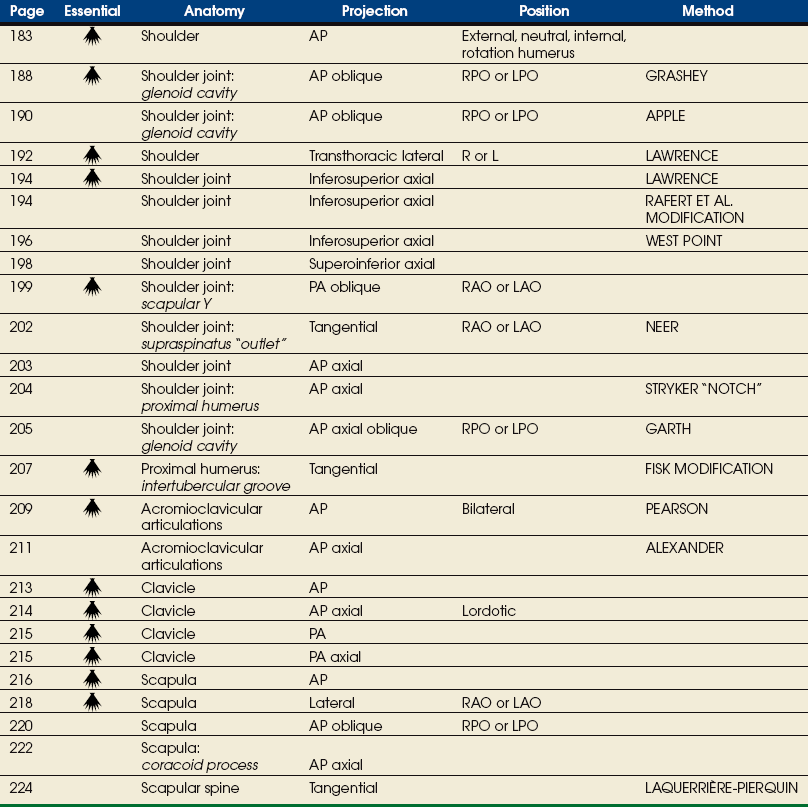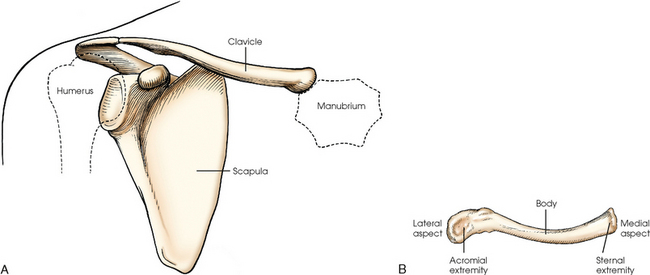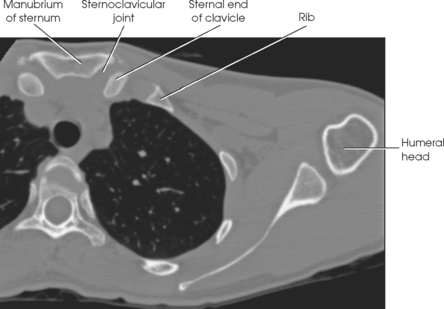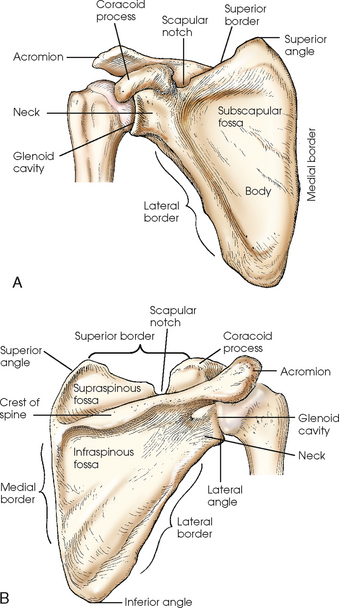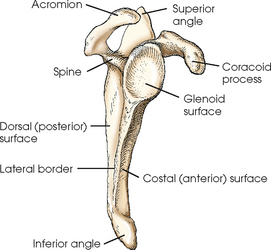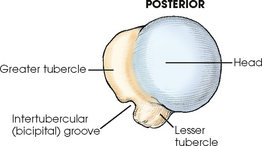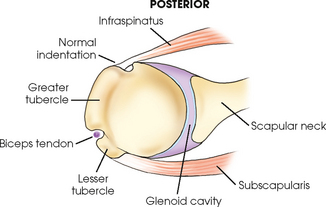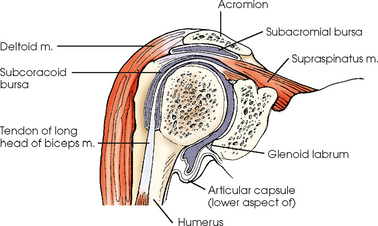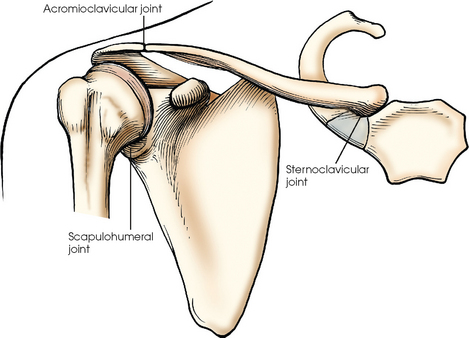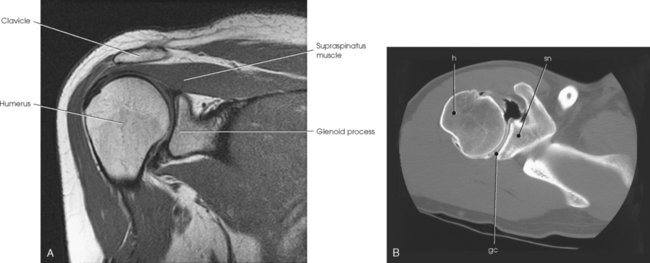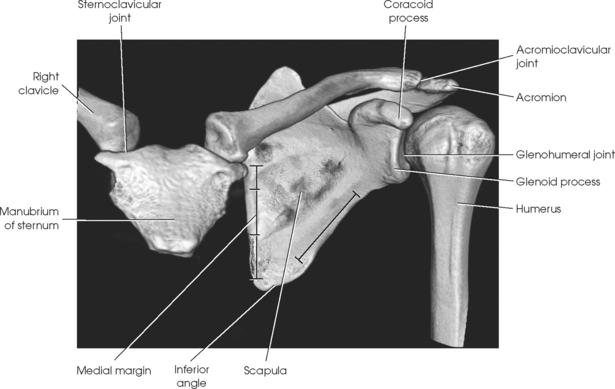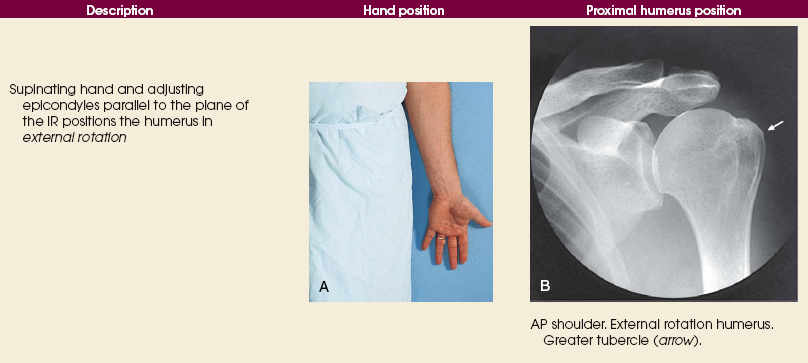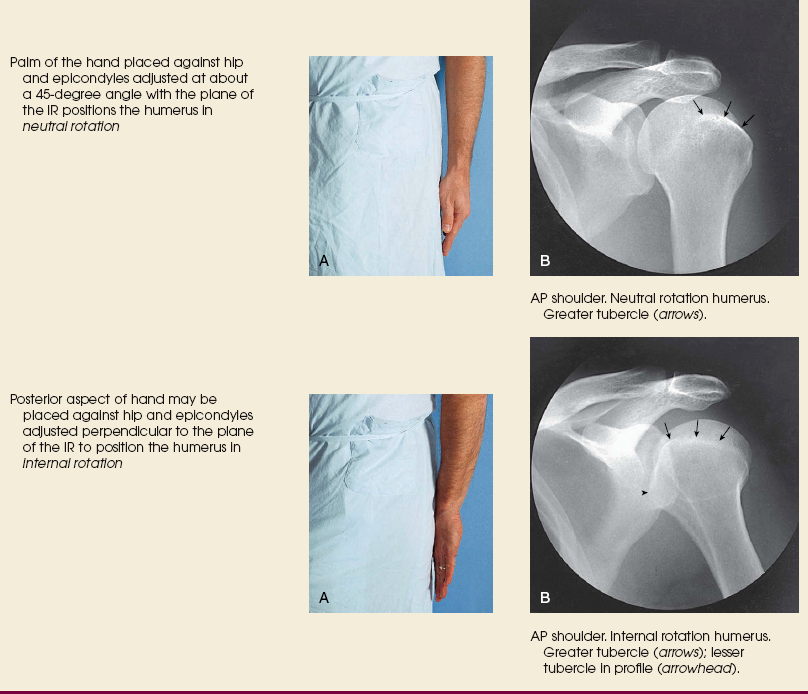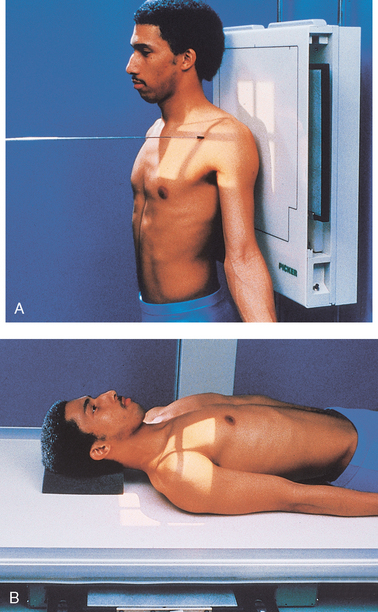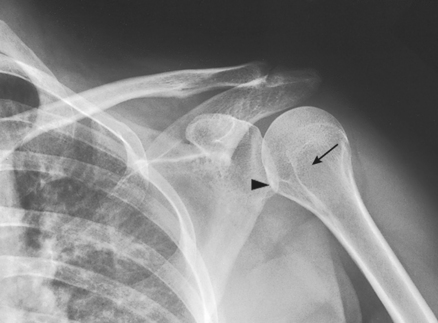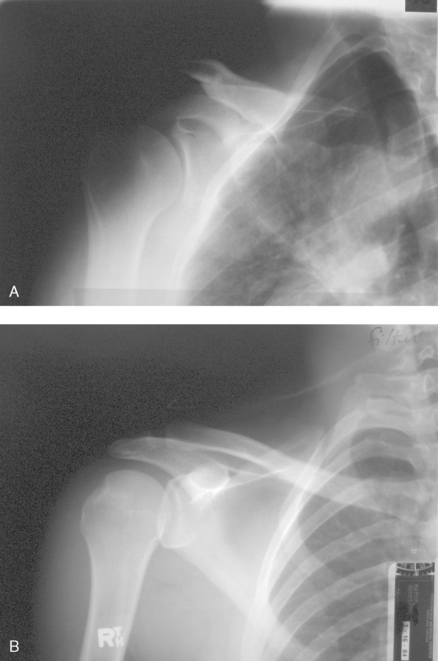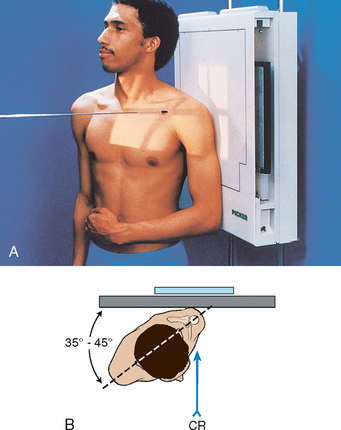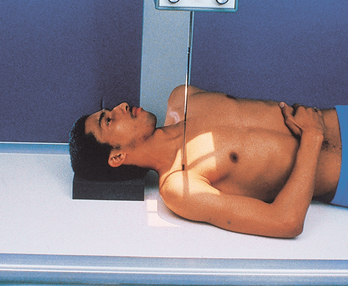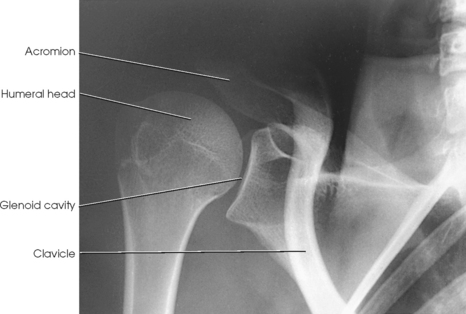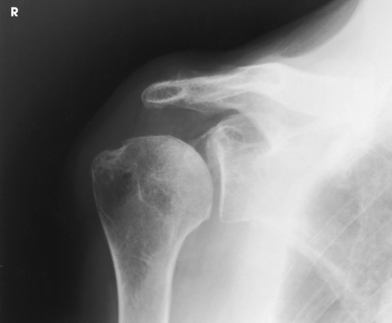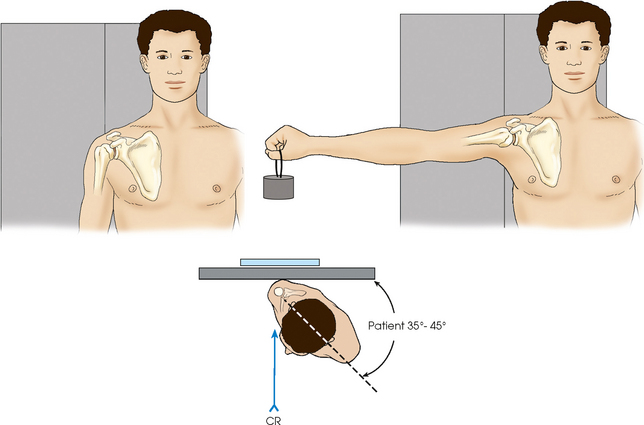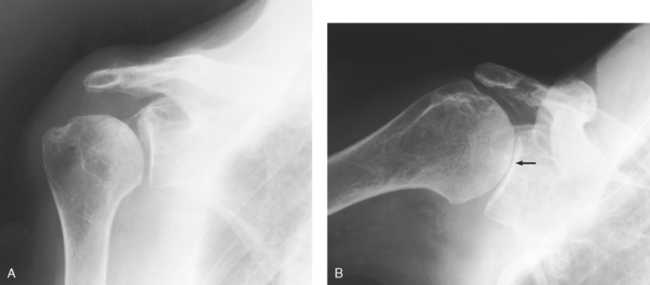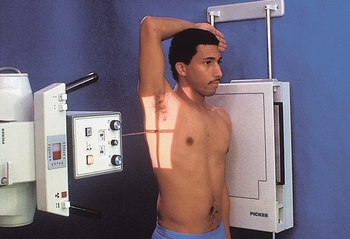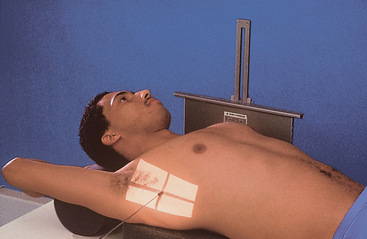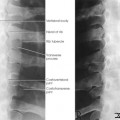5 The shoulder girdle is formed by two bones—the clavicle and scapula. The function of these bones is to connect the upper limb to the trunk. Although the alignment of these two bones is considered a girdle, it is incomplete in front and in back. The girdle is completed in front by the sternum, which articulates with the medial end of the clavicle. The scapulae are widely separated in the back. The proximal portion of the humerus is part of the upper limb and not the shoulder girdle proper; however, because the proximal humerus is included in the shoulder joint, its anatomy is considered with that of the shoulder girdle (Figs. 5-1 and 5-2). The clavicle, classified as a long bone, has a body and two articular extremities (see Fig. 5-1). The clavicle lies in a horizontal oblique plane just above the first rib and forms the anterior part of the shoulder girdle. The lateral aspect is termed the acromial extremity, and it articulates with the acromion process of the scapula. The medial aspect, termed the sternal extremity, articulates with the manubrium of the sternum and the first costal cartilage. The clavicle, which serves as a fulcrum for the movements of the arm, is doubly curved for strength. The curvature is more acute in males than in females. The scapula, classified as a flat bone, forms the posterior part of the shoulder girdle (Figs. 5-3 and 5-4). Triangular in shape, the scapula has two surfaces, three borders, and three angles. Lying on the superoposterior thorax between the second and seventh ribs, the medial border of the scapula runs parallel with the vertebral column. The body of the bone is arched from top to bottom for greater strength, and its surfaces serve as the attachment sites of numerous muscles. The flat aspect of the bone lies at about a 45- to 60-degree angle in relation to the anatomic position (see Fig. 5-2). The superior angle is formed by the junction of the superior and medial borders. The inferior angle is formed by the junction of the medial (vertebral) and lateral borders and lies over the seventh rib. The lateral angle, the thickest part of the body of the scapula, ends in a shallow, oval depression called the glenoid cavity. The constricted region around the glenoid cavity is called the neck of the scapula. The coracoid process arises from a thick base that extends from the scapular notch to the superior portion of the neck of the scapula. This process projects first anteriorly and medially and then curves on itself to project laterally. The coracoid process can be palpated just distal and slightly medial to the acromioclavicular articulation. The proximal end of the humerus consists of a head, an anatomic neck, two prominent processes called the greater and lesser tubercles, and the surgical neck (Fig. 5-5). The head is large, smooth, and rounded, and it lies in an oblique plane on the superomedial side of the humerus. Just below the head, lying in the same oblique plane, is the narrow, constricted anatomic neck. The constriction of the body just below the tubercles is called the surgical neck, which is the site of many fractures. Fig. 5-5 A, Anterior aspect of right proximal humerus. B, Photograph of anterior aspect of proximal humerus. The lesser tubercle is situated on the anterior surface of the bone, immediately below the anatomic neck (Figs. 5-6 and 5-7; see Fig. 5-5). The tendon of the subscapular muscle inserts at the lesser tubercle. The greater tubercle is located on the lateral surface of the bone, just below the anatomic neck, and is separated from the lesser tubercle by a deep depression called the intertubercular (bicipital) groove. The superior surface of the greater tubercle slopes posteriorly at an angle of approximately 25 degrees and has three flattened impressions for muscle insertions. The anterior impression is the highest of the three and affords attachment to the tendon of the supraspinatus muscle. The middle impression is the point of insertion of the infraspinatus muscle. The tendon of the upper fibers of the teres minor muscle inserts at the posterior impression (the lower fibers insert into the body of the bone immediately below this point). Bursae are small, synovial fluid–filled sacs that relieve pressure and reduce friction in tissue. They are often found between the bones and the skin, and they allow the skin to move easily when the joint is moved. Bursae are found also between bones and ligaments, muscles, or tendons. One of the largest bursae of the shoulder is the subacromial bursa (Fig. 5-8). It is located under the acromion process and lies between the deltoid muscle and the shoulder joint capsule. The subacromial bursa does not normally communicate with the joint. Other bursae of the shoulder are found superior to the acromion, between the coracoid process and the joint capsule, and between the capsule and the tendon of the subscapular muscle. Bursae become important radiographically when injury or age causes the deposition of calcium. The three joints of the shoulder girdle are summarized in Table 5-1, and a detailed description follows. The scapulohumeral articulation between the glenoid cavity and the head of the humerus forms a synovial ball-and-socket joint, allowing movement in all directions (Figs. 5-9 and 5-10). This joint is often referred to as the glenohumeral joint. Although many muscles connect with, support, and enter into the function of the shoulder joint, radiographers are chiefly concerned with the insertion points of the short rotator cuff muscles (Fig. 5-11). The insertion points of these muscles—the subscapular, supraspinatus, infraspinatus, and teres minor—have already been described. An articular capsule completely encloses the shoulder joint. The tendon of the long head of the biceps brachii muscle, which arises from the superior margin of the glenoid cavity, passes through the capsule of the shoulder joint, goes between its fibrous and synovial layers, arches over the head of the humerus, and descends through the intertubercular (bicipital) groove. The short head of the biceps arises from the coracoid process and, with the long head of the muscle, inserts in the radial tuberosity. Because it crosses with the shoulder and elbow joints, the biceps help synchronize their action. The acromioclavicular (AC) articulation between the acromion process of the scapula and the acromial extremity of the clavicle forms a synovial gliding joint (see Fig. 5-12). It permits gliding and rotary (elevation, depression, protraction, and retraction) movement. Because the end of the clavicle rides higher than the adjacent surface of the acromion, the slope of the surfaces tends to favor displacement of the acromion downward and under the clavicle. The sternoclavicular (SC) articulation is formed by the sternal extremity of the clavicle with two bones: the manubrium and the first rib cartilage (see Fig. 5-12). The union of the clavicle with the manubrium of the sternum is the only bony union between the upper limb and trunk. This articulation is a synovial double-gliding joint. The joint is adapted by a fibrocartilaginous disk, however, to provide movements similar to a ball-and-socket joint: circumduction, elevation, depression, and forward and backward movements. The clavicle carries the scapula with it through any movement. *kVp values are for a three-phase, 12-pulse generator or high frequency. †Relative doses for comparison use. All doses are skin entrance for average adult at cm indicated. ‡Bucky, 16:1 grid. Screen-film speed 300. §Tabletop, 8:1 grid. Screen-film speed 300. ¶Tabletop, standard IR. Screen-film speed 300 or equivalent CR. Protection of the patient from unnecessary radiation is a professional responsibility of the radiographer (see Chapters 1 and 2 for specific guidelines). In this chapter, the Shield gonads statement at the end of the Position of part section indicates that the patient is to be protected from unnecessary radiation by using proper collimation and placing lead shielding between the gonads and the radiation source to restrict the radiation beam. NOTE: Do not have the patient rotate the arm if fracture or dislocation is suspected. • Center the shoulder joint to the midline of the grid. • Adjust the position of the IR so that its center is 1 inch (2.5 cm) inferior to the coracoid process. • Ask the patient to supinate the hand, unless contraindicated (Table 5-2). • Abduct the arm slightly, and rotate it so that the epicondyles are parallel with the plane of the IR. Externally rotating the entire arm from the neutral position places the shoulder and entire humerus in the true anatomic position (Fig. 5-13). • Ask the patient to rest the palm of the hand against the thigh (see Table 5-2). This position of the arm rolls the humerus slightly internal into a neutral position, placing the epicondyles at an angle of about 45 degrees with the plane of the IR. Structures shown: The image shows the bony and soft structures of the shoulder and proximal humerus in the anatomic position (Figs. 5-14 to 5-16). The scapulohumeral joint relationship is seen. External rotation: The greater tubercle of the humerus and the site of insertion of the supraspinatus tendon are visualized (see Fig. 5-14, A). Neutral rotation: The posterior part of the supraspinatus insertion, which sometimes profiles small calcific deposits not otherwise visualized (see Fig. 5-14, B), is seen. Internal rotation: The proximal humerus is seen in a true lateral position. When the arm can be abducted enough to clear the lesser tubercle of the head of the scapula, a profile image of the site of the insertion of the subscapular tendon is seen (see Fig. 5-15). Image receptor: 8 × 10 inch (18 × 24 cm) crosswise • Center the IR to the scapulohumeral joint. The joint is 2 inches (5 cm) medial and 2 inches (5 cm) inferior to the superolateral border of the shoulder. • Rotate the body approximately 35 to 45 degrees toward the affected side (Fig. 5-17). • Adjust the degree of rotation to place the scapula parallel with the plane of the IR. This is accomplished by orienting the plane through the superior angle of the scapula and acromial tip, parallel to the IR.* The head of the humerus is in contact with the IR. • If the patient is in the recumbent position, the body may need to be rotated more than 45 degrees (up to 60 degrees) to place the scapula parallel to the IR. • Support the elevated shoulder and hip on sandbags (Fig. 5-18). • Abduct the arm slightly in internal rotation, and place palm of the hand on the abdomen. The Apple method1 is similar to the Grashey method but uses weighted abduction to show a loss of articular cartilage in the scapulohumeral joint. • Center the IR to the scapulohumeral joint. • Rotate the body approximately 35 to 45 degrees toward the affected side. • The posterior surface of affected side is closest to the IR. • The scapula should be positioned parallel to the plane of the IR (see Grashey method for positioning details). • The patient should hold a 1-lb weight in the hand on the same side as the affected shoulder in a neutral position. • While holding the weight, the patient should abduct the arm 90 degrees from the midline of the body (Fig. 5-21). The Lawrence1 method is used when trauma exists, and the arm cannot be rotated or abducted because of an injury. This projection shows the proximal humerus in a 90-degree projection from the AP projection and shows its relationship to the scapula and clavicle. • Although this projection can be carried out with the patient in the upright or supine position, the upright position is much easier on a trauma patient. It also assists accurate adjustment of the shoulder. • For upright positioning, seat or stand the patient in the lateral position before a vertical grid device (Fig. 5-23). • If an upright position is impossible, place the patient in a recumbent position on the table with radiolucent pads elevating the head and shoulders (Fig. 5-24). • Have the patient raise the noninjured arm, rest the forearm on the head, and elevate the shoulder as much as possible (see Fig. 5-23). Elevation of the noninjured shoulder drops the injured side, separating the shoulders to prevent superimposition. Ensure that the midcoronal plane is perpendicular to the IR. • No attempt should be made to rotate or otherwise to move the injured arm.
SHOULDER GIRDLE
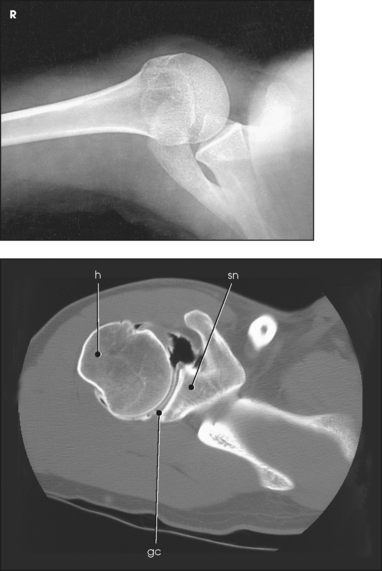
Shoulder Girdle
Clavicle
Scapula
Humerus

Shoulder Girdle Articulations
SCAPULOHUMERAL ARTICULATION
ACROMIOCLAVICULAR ARTICULATION
STERNOCLAVICULAR ARTICULATION
SUMMARY OF PATHOLOGY
Condition
Definition
Bursitis
Inflammation of the bursa
Dislocation
Displacement of a bone from the joint space
Fracture
Disruption in the continuity of bone
Hills-Sachs defect
Impacted fracture of posterolateral aspect of the humeral head with dislocation
Metastases
Transfer of a cancerous lesion from one area to another
Osteoarthritis or degenerative joint disease
Form of arthritis marked by progressive cartilage deterioration in synovial joints and vertebrae
Osteopetrosis
Increased density of atypically soft bone
Osteoporosis
Loss of bone density
Rheumatoid arthritis
Chronic, systemic, inflammatory collagen disease
Tendinitis
Inflammation of the tendon and tendon-muscle attachment
Tumor
New tissue growth where cell proliferation is uncontrolled
Chondrosarcoma
Malignant tumor arising from cartilage cells
EXPOSURE TECHNIQUE CHART ESSENTIAL PROJECTIONS
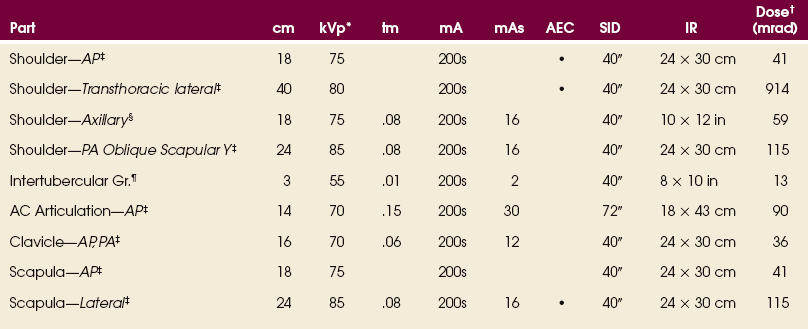
Radiation Protection
Shoulder
External, neutral, internal rotation humerus
![]() COMPENSATING FILTER
COMPENSATING FILTER
Glenoid Cavity
RPO or LPO position
Glenoid Cavity
RPO or LPO position
Shoulder
![]() TRANSTHORACIC LATERAL PROJECTION
TRANSTHORACIC LATERAL PROJECTION
R or L position
![]()
Stay updated, free articles. Join our Telegram channel

Full access? Get Clinical Tree



